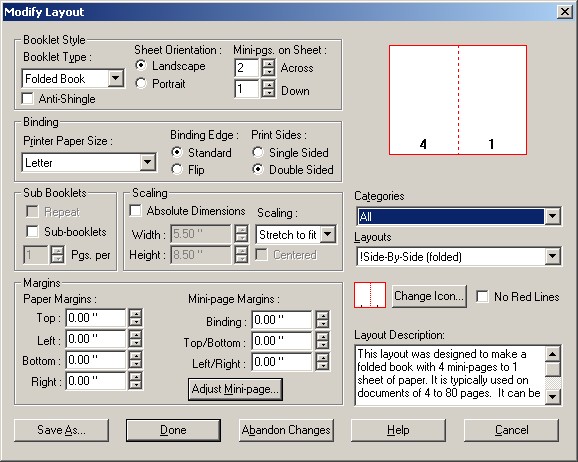
|
Modify Layout
|
Previous Top Next |

|
| · | Booklet Style:
|
| · | Booklet Type - Select a booklet style such as Cut book, Folded book, French fold, Planner pages, Poster, Tiled, and Tri-fold.
|
| · | Anti-Shingle - In large folded booklets with more than 10 sheets of paper the edges start to creep out in the center until the edge looks like a V. We call this shingling. ClickBook Enterprise can move the page towards the center so you can cut off excess paper without cutting into printed text.
|
| · | Mini-pgs. on Sheet - Select how many pages to put on a single sheet of paper.
|
| · | Sheet Orientation - Select if you want the sheet to print in Portrait or Landscape Orientation.
|
| · | Binding
|
| · | Printer Paper Size - Select the size of paper you want to use. This will override the default setting that is under Tools->Options.
|
| · | Binding Edge - Choose how you want the binding edge.
|
| · | Print Sides - Select to print on one side or both sides of paper.
|
| · | Sub Booklets
|
| · | Repeat - The effect of Repeat depends on the current Layout. Repeat can be used to print more copies when there aren't enough mini-pages to fill the sheet. Repeat can also be used, alternatively, to avoid the step of assembling multiple booklets.
|
| · | Sub-Booklets - Rather than folding a whole booklet together, you may wish to print and fold sub-booklets separately, and then bind them together. Mark the check box to activate sub-booklet printing. Then set Pages-per to the number of pages you want each sub-booklet to contain.
|
| · | Scaling
|
| · | Absolute Dimensions - ClickBook Enterprise sets the Mini-page dimensions to fill a sheet of paper. You can set the dimensions by turning on Absolute Dimensions.
|
| · | Width - Specify the width to match a custom page size.
|
| · | Height - Specify the height to match a custom page size.
|
| · | Scaling - Choose the type of scaling to use, either One to One, No Scaling, or Stretch to fit.
|
| · | Margins
|
| · | Paper Margins - Allows you to change the margins for a sheet of paper.
|
| · | Mini-Page Margins - Allows you to change the mini-page margins for the current Layout.
|
| · | Save As... - Opens the Save As dialog box to save the layout with a new name.
|
| · | Done - Saves any changes made to the current Layout.
|
| · | Abandon Changes - Reverts to the layout's previous settings.
|
| · | Cancel - Closes the Modify Layouts dialog.
|
| · | Paper Orientation - This lets you choose the orientation of the pages in the poster.
|
| · | Pages on Poster - This specifies how many pages will be printed per poster. Across specifies the number of pages going horizontally, and Down specifies the number of pages going vertically.
|
| · | Poster Margins - The top and left margins specify how far over the poster will begin printing from the upper-left corner of the first piece of paper. In most cases it makes sense to leave these at 0, unless you are missing part of your poster because of the non-printable area of your printer.
|
| · | Poster Cropping - This will stretch your document to fit the poster in one direction and crop off the other dimension if the document does not fit exactly.
|
| · | Scaling (Width/Height) - This is the total width and height of the poster after assembly.
|
| · | Overlap - This specifies how much overlap in each poster page. The pages intentionally overlap because most printers cannot print to the edge of the paper so there would be white gaps on the poster. You should trim off the white non-printable area before taping the poster together.
|